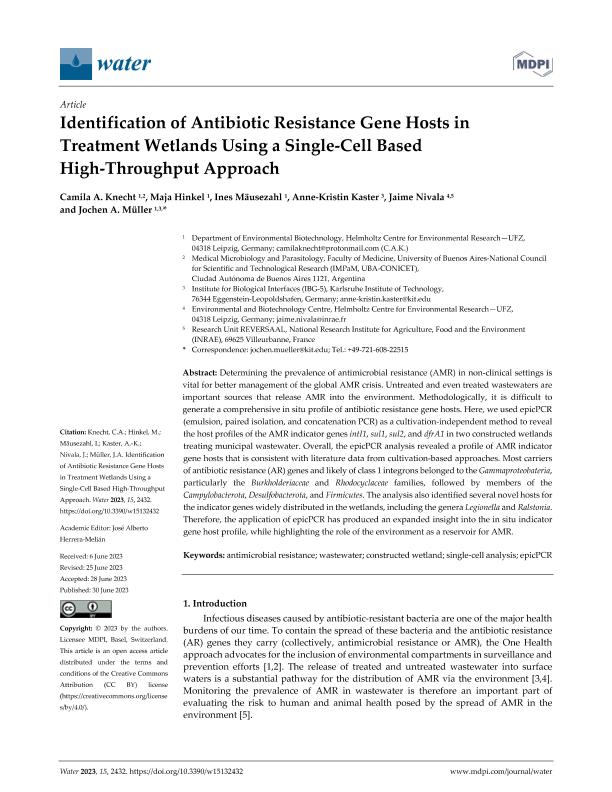Artículo
Identification of Antibiotic Resistance Gene Hosts in Treatment Wetlands Using a Single-Cell Based High-Throughput Approach
Knecht, Camila Ayelén ; Hinkel, Maja; Mäusezahl, Ines; Kaster, Anne Kristin; Nivala, Jaime; Müller, Jochen A.
; Hinkel, Maja; Mäusezahl, Ines; Kaster, Anne Kristin; Nivala, Jaime; Müller, Jochen A.
 ; Hinkel, Maja; Mäusezahl, Ines; Kaster, Anne Kristin; Nivala, Jaime; Müller, Jochen A.
; Hinkel, Maja; Mäusezahl, Ines; Kaster, Anne Kristin; Nivala, Jaime; Müller, Jochen A.
Fecha de publicación:
06/2023
Editorial:
MDPI
Revista:
Water
ISSN:
2073-4441
Idioma:
Inglés
Tipo de recurso:
Artículo publicado
Clasificación temática:
Resumen
Determining the prevalence of antimicrobial resistance (AMR) in non-clinical settings is vital for better management of the global AMR crisis. Untreated and even treated wastewaters are important sources that release AMR into the environment. Methodologically, it is difficult to generate a comprehensive in situ profile of antibiotic resistance gene hosts. Here, we used epicPCR (emulsion, paired isolation, and concatenation PCR) as a cultivation-independent method to reveal the host profiles of the AMR indicator genes intI1, sul1, sul2, and dfrA1 in two constructed wetlands treating municipal wastewater. Overall, the epicPCR analysis revealed a profile of AMR indicator gene hosts that is consistent with literature data from cultivation-based approaches. Most carriers of antibiotic resistance (AR) genes and likely of class 1 integrons belonged to the Gammaproteobateria, particularly the Burkholderiaceae and Rhodocyclaceae families, followed by members of the Campylobacterota, Desulfobacterota, and Firmicutes. The analysis also identified several novel hosts for the indicator genes widely distributed in the wetlands, including the genera Legionella and Ralstonia. Therefore, the application of epicPCR has produced an expanded insight into the in situ indicator gene host profile, while highlighting the role of the environment as a reservoir for AMR.
Archivos asociados
Licencia
Identificadores
Colecciones
Articulos(IMPAM)
Articulos de INSTITUTO DE INVESTIGACIONES EN MICROBIOLOGIA Y PARASITOLOGIA MEDICA
Articulos de INSTITUTO DE INVESTIGACIONES EN MICROBIOLOGIA Y PARASITOLOGIA MEDICA
Citación
Knecht, Camila Ayelén; Hinkel, Maja; Mäusezahl, Ines; Kaster, Anne Kristin; Nivala, Jaime; et al.; Identification of Antibiotic Resistance Gene Hosts in Treatment Wetlands Using a Single-Cell Based High-Throughput Approach; MDPI; Water; 15; 13; 6-2023; 1-16
Compartir
Altmétricas



